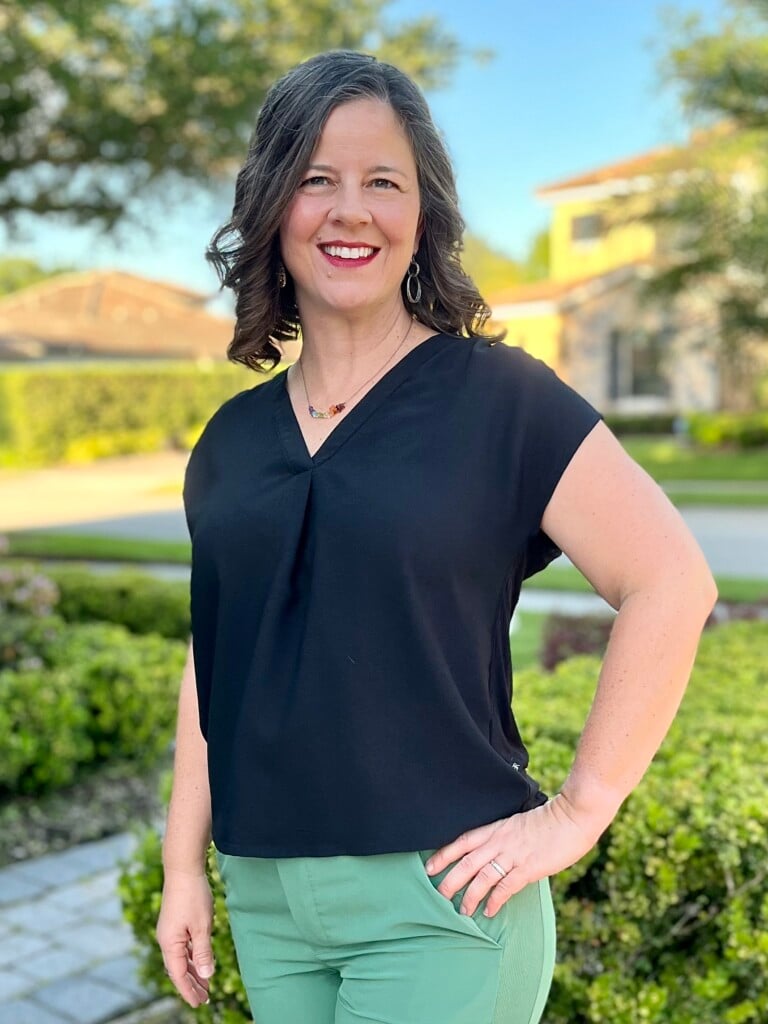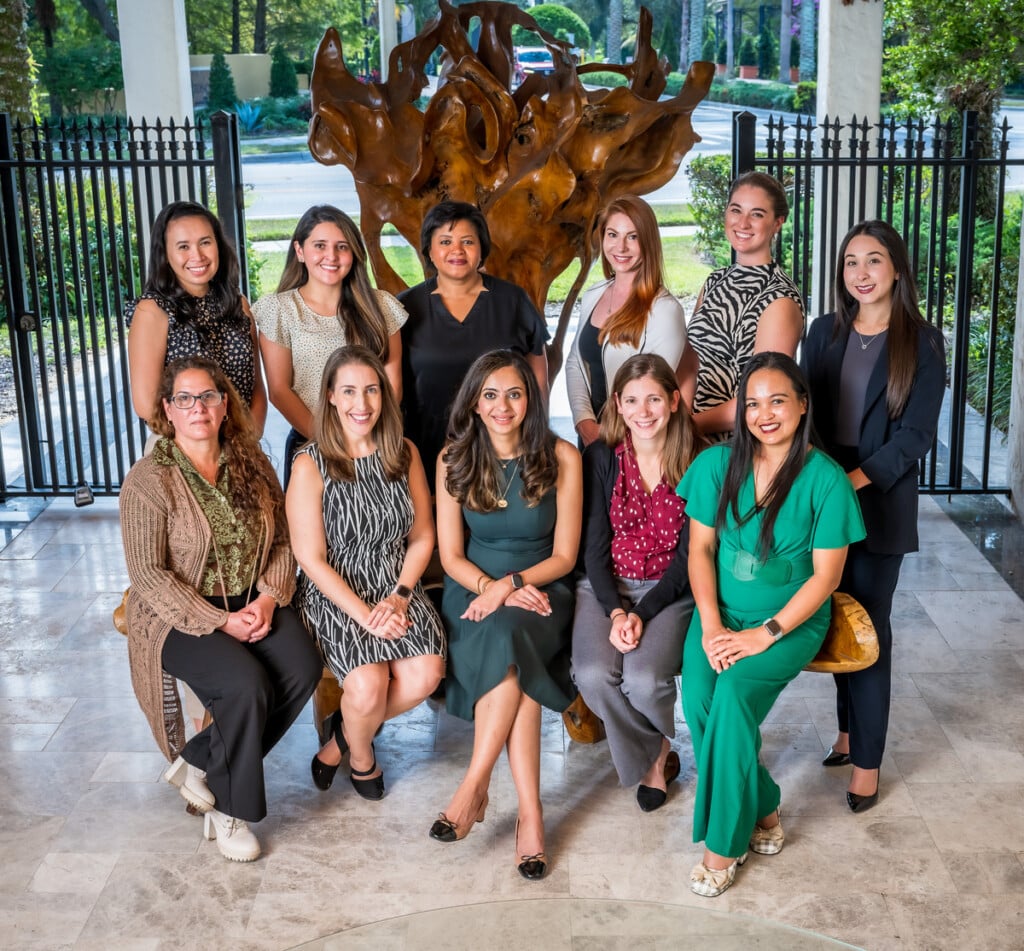Finest Doctors of 2020: The Mysteries of COVID-19
Why are children often spared? What treatments might work? With infectious disease in the spotlight, some local experts explain—and offer sage advice. By Susan Jenks

Dr. Kenneth Alexander of Nemours Children’s Hospital, with co-worker Abigail Nazario. (ROBERTO GONZALEZ)
Long before the current pandemic, Dr. Federico Laham encountered an infection in a 16-year-old Orlando girl that still haunts him today.
A year after arriving at Arnold Palmer Hospital for Children in 2010, he says, he helped treat the teenager after she picked up an infection from a brain-eating amoeba while swimming in the St. Johns River.
“It was something she’d done her whole life, swimming there,” he says of the river where the single-celled organism, Naegleria fowleri, entered through the girl’s nose to attack her brain. Although millions of people are exposed to these amoeba in freshwater lakes and ponds, experts say, only a handful get sick, for reasons that remain poorly understood.
“She passed within 72 hours,” Laham says sadly, recalling the unusual, yet invariably fatal infection only seen in two other children at the hospital since. “I still remember her.”
In the intervening decade, Laham, the medical director of pediatric infectious diseases at Arnold Palmer, has diagnosed and treated many other children whose acute or chronic infections may be caused by an array of more common viruses, bacteria, fungi and even the occasional prion, a miniscule protein behind several degenerative brain diseases.
But not surprisingly, like most of his infectious disease colleagues nationwide, he now focuses on the many medical uncertainties surrounding the novel virus causing COVID-19 as it sweeps the globe. Whereas in the past, these physicians operated primarily in the background, today they’re at the forefront of medical efforts to stem the virus’ rapid trajectory, as new testing strategies evolve, along with better therapeutics to control it.
That means taking measures daily to protect patients and health care staff alike through rapidly identifying the sick and isolating them, while requiring everyone to wear masks—widely viewed as a singular deterrent to viral spread, until a vaccine becomes available, possibly by early 2021.
“None of us who worked through the recent peak in July ever want to go through that again,” Laham says, referring to an early spike in severe infections in Central Florida.
In an unexpected finding contrary to other disease outbreaks, Laham and others say, children have been largely spared from the worst ravages of this fast-moving pathogen, except for a rare inflammatory condition that can develop two to six weeks after infection. Overall, of those testing positive in the Orlando area, relatively few infections have been in children. And, so far, according to the Centers for Disease Control and Prevention in Atlanta, state-level reports show that the death rate among children remains low in Florida and elsewhere in the country.
“COVID-19 is very peculiar,” says Dr. Kenneth Alexander, chief of the division of pediatric infectious diseases at Nemours Children’s Hospital in Orlando. “Children are usually the canary in the coal mine,” or the first ones to get any new, emerging disease during an outbreak, he says.
With COVID-19, though, “we realized quickly that most children were going to be fine”—a disease pattern borne out inside area hospitals, with few acute cases requiring hospitalization. Also, the handful of children who have developed inflammatory reactions following a viral infection, Alexander says, underwent successful treatment with steroids and antibodies in the hospital and were then released.
Why children seem to fare so much better than adults, especially those past age 60, is not yet clear, though many reports have shown the youngest children can quietly pass these infections to others, primarily their adult caregivers. “These adult caregivers are the people who need to do everything to protect themselves” by wearing masks, social distancing and frequent handwashing, Alexander says.
One theory behind the seeming immunity children enjoy holds that most of them make only small quantities of a specific protein, the ACE2 receptor, or angiotension converting enzyme-2 receptor, which acts as a cellular gateway to healthy cells throughout the body. Because doctors know that older people as they age produce more of these proteins —associated with both heart and pulmonary diseases—the increased number presumably gives the COVID-19 virus more opportunity to invade, replicate and survive.
All of the major vaccine efforts furthest along and many evolving treatments under way target the coronavirus’ spike protein, which binds to the ACE-2 receptor, allowing the virus to latch on to and enter these cells. The spike protein gives the virus its microscopic crown-like appearance and “is definitely the center of research attention,” Alexander says—the hope being to block the virus’ entry through this portal.
Over the past two decades, scientists have identified a large family of coronaviruses that circulate widely in the animal world, yet pose no threat to humans. But, in addition to four commonly circulating viruses that usually cause mild-to-moderate disease in humans, three others recently identified crossed species lines to cause severe disease, including COVID-19. (Technically, the term, COVID-19 refers to the disease, not the specific underlying coronavirus, SARS-CoV-2). This newest of the coronaviruses first emerged in China in December last year, igniting the global pandemic that began in March.
Although scientists quickly traced the infection source to bats killed in the open-air markets of the city of Wuhan, they don’t know yet whether there’s an intermediary species that helps the virus along.
“Many of these viruses flare up and simply disappear,” Alexander says, like the Zika virus, which requires a mosquito for transmission and has largely died out with effective mosquito control. But given the efficiency of human transmission of the virus that causes COVID-19, he says, that might not happen this time. “We think it’s going to stick around for a long time.”
Since March, the rate of COVID-19 infections has continued to fluctuate widely around the globe, with episodic surges occurring unevenly in many countries. The rate in the United States—which passed 11 million cases in mid-November—is among the highest in the world and differs state by state, depending in large part, health officials say, on whether prevention measures like masking are being followed.
For physicians, one of the most challenging aspects of this disease has been the wide spectrum of symptoms they see in patients, says Dr. Victor Herrera, a specialist in infectious diseases and associate medical officer of AdventHealth Orlando. Some have mild or no symptoms at all, he says, while others are deathly ill—differences still under study. So, too, are a number of experimental treatments to fight the disease in the most seriously ill patients.
One treatment, convalescent plasma, involves transfusing the blood of a recovering COVID-19 patient to treat someone who’s currently sick. Both AdventHealth and Orlando Health physicians have treated patients in this way for several months, as have some doctors in private practice in the Orlando area.
“Convalescent plasma used to be a research project; now it’s openly available,” says Dr. Archana Shah, the founder of Premier Infectious Disease Care in Winter Park. “I’ve given it to very sick patients who are not doing better with remdesivir or steroids”—often a last resort before placing them on a ventilator, she says.
Although early in the pandemic, she saw many patients who needed ventilator help to breathe, Shah says that those numbers lessened with time. Not only have doctors become more adept at hands-on management, she suggests, they have more treatment options and better testing available, from nasal swabs to saliva tests, to help identify individuals at highest risk of infection.
At AdventHealth, Herrera and his colleagues, in fact, have piloted a rapid antigen test for health care workers exposed to COVID-19, although the study has not yet been published or reviewed by peers. These rapid tests, which offer results in as little as 15 minutes, identify pieces of viral protein that elicit an immune response. Many experts believe they offer a cheaper, low-tech alternative for tracking the virus’ path and identifying those needing immediate medical care much faster than the current gold standard— a highly accurate but labor-intensive molecular test known as PCR.
“We do much more testing now” of all types from nasal swabs to antibody and antigen testing, says Dr. Antonio Crespo, the medical director of infectious disease for Orlando Health Medical Group, noting a stark contrast with more limited testing at the pandemic’s beginning.
And while there have been other viruses in the past, such as swine flu, where people can become infected yet show no symptoms, he says, “we’ve never seen anything of this magnitude before.”
Besides the elderly, the most vulnerable patients tend to be household members living in close quarters, the obese and those with weakened immunity from other underlying health conditions, he says, but “everyone can get it.’’ Nor is the disease exclusively a respiratory problem. European studies have shown heart problems following infection in some patients, especially aberrant heart rhythms that raise the risk of stroke, while others report patients develop fatigue that can lasts for months.
So far, though there’s no evidence the virus lies dormant after infection, only to reappear later, Crespo says. In general, he describes its typical course of infection as a “fierce storm that slowly goes away.”
But, with cold weather approaching, even in parts of Florida, Crespo and others worry about people’s exposures to both influenza and the virus causing COVID-19 at the same time, or that the two viruses might commingle somehow—a worst-case scenario.
“So get your flu shot now, rather than wait for a COVID-19 vaccine to come along,” he strongly advises. And “wear a mask and social distance because you still don’t know if you’re exposing a loved one.’’
The Choice
The high price of natural herd immunity vs. simple alternatives. By Susan Jenks
During the coronavirus pandemic, the term “herd immunity’ has swept through the country almost as quickly as the novel virus itself.
What it means in simple terms, health experts say, is that enough people in the general population become infected and immune to a pathogen, like the one causing COVID-19, that it creates an umbrella effect, with person-to-person transmission no longer possible. Or it could occur, they say, if there’s an effective vaccine, which provides widespread immunity.
As of late November, nearly 13 million people in the United States had been infected with the virus causing COVID-19 and more than 262,000 people had died.
To reach herd immunity, estimates suggest at 60 percent or more of the population needs to be immune, raising the possibility if that happens, over 1.2 million Americans might die, says Dr. Kenneth Alexander, chief of the division of pediatric infectious diseases at Nemours Chidren’s Hospital in Orlando. “So the question becomes what death rate are you willing to accept to keep your bar open?”
Other local infectious disease experts agree that the goal of herd immunity by natural infection carries too high a price, especially when public health measures, such as masking, social distancing, contact tracing and good hygiene work well to slow disease spread, even for more contagious diseases, like measles.
“I don’t think it’s a wise path to follow,” says Dr. Federico Hinestrosa, one of three infectious disease specialists at Orlando Immunology Center. “You’ll run into big trouble first, with significant numbers of complications and death.”
Also, masking alone, public health officials now say, may be enough to keep a lid on the virus’ rapid trajectory until a vaccine becomes available.
If practiced universally, masking could slash dramatically COVID-19’s death tolls around the globe and in the United States, according to the Institute for Health Metrics and Evaluation at the University of Washington’s School of Medicine. The institute’s projections show mask-wearing could cut anticipated COVID-19 deaths in the U.S. from 363,269 to 278,526 by January of 2021. If, however, mandates are eased, the data suggests, deaths in the U.S. from COVID-19 could climb as high 427,538 by then.
“Masking is definitely key,” says Dr. Archana Shah, an infectious disease specialist at Premier Infectious Disease Care in Winter Park. “If everyone had worn masks since March, we might be at the end of this now.”
Instead, “we’re still in a marathon,” she says, “and we’re not sure where it’s going to end.”







